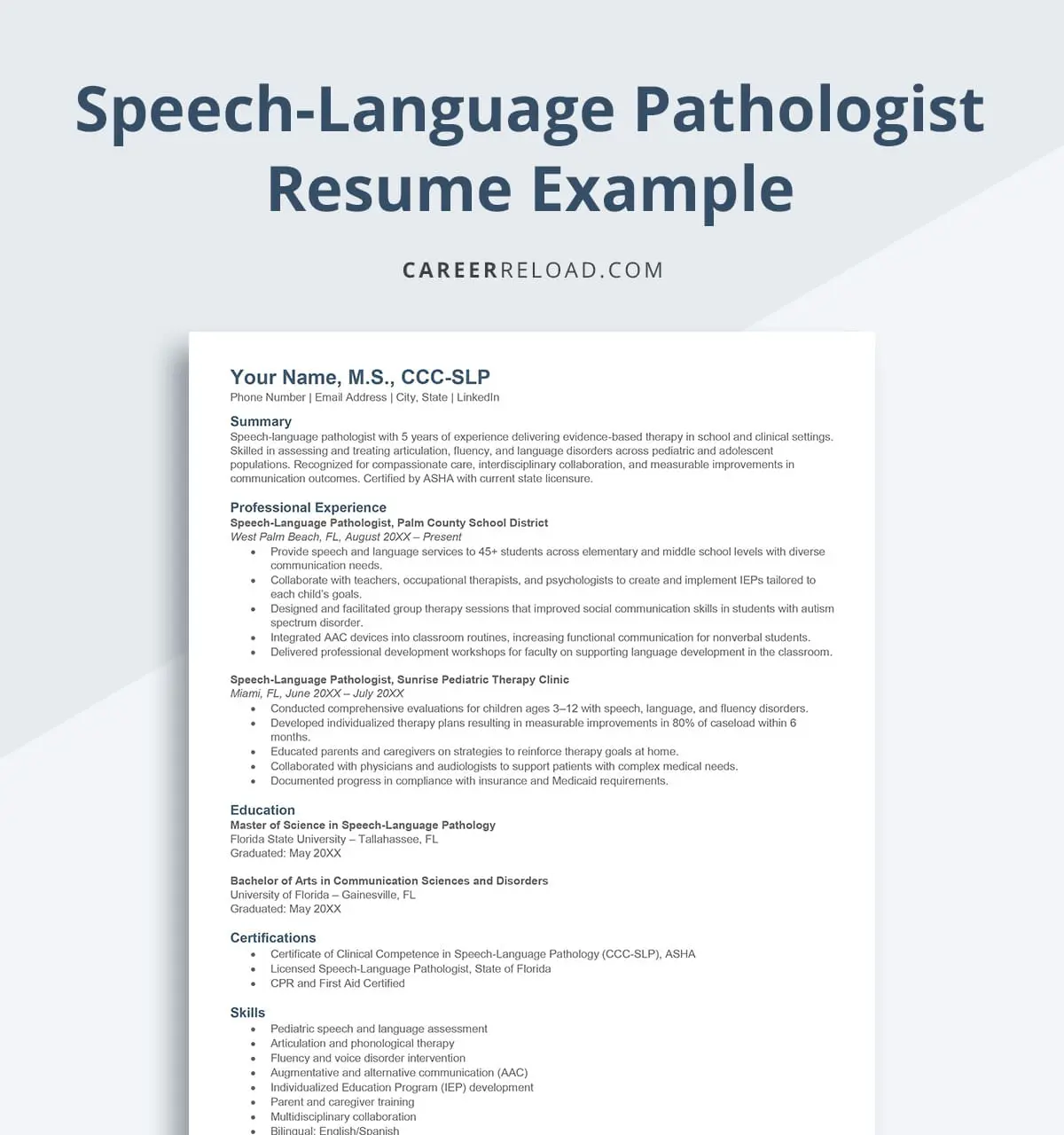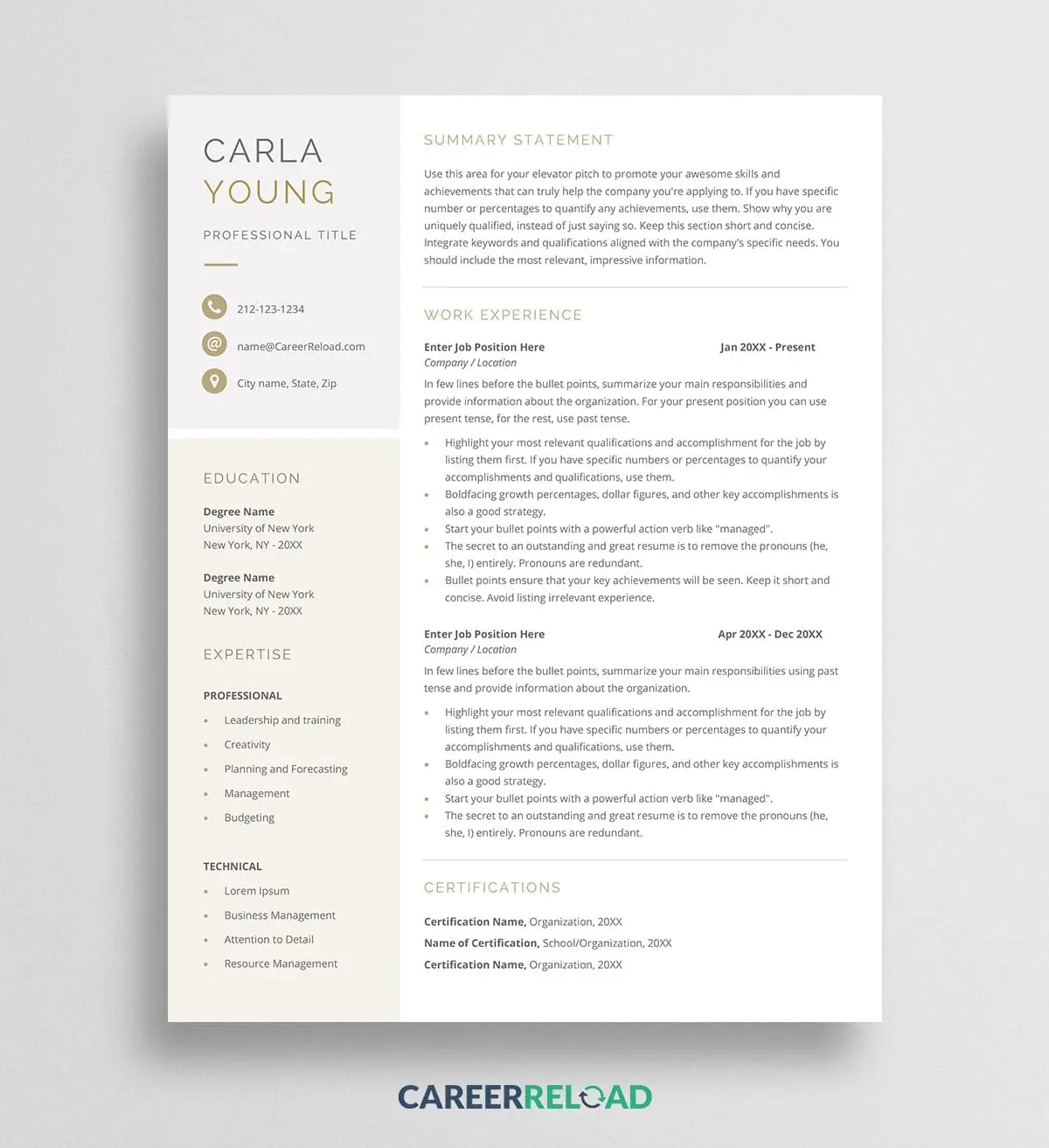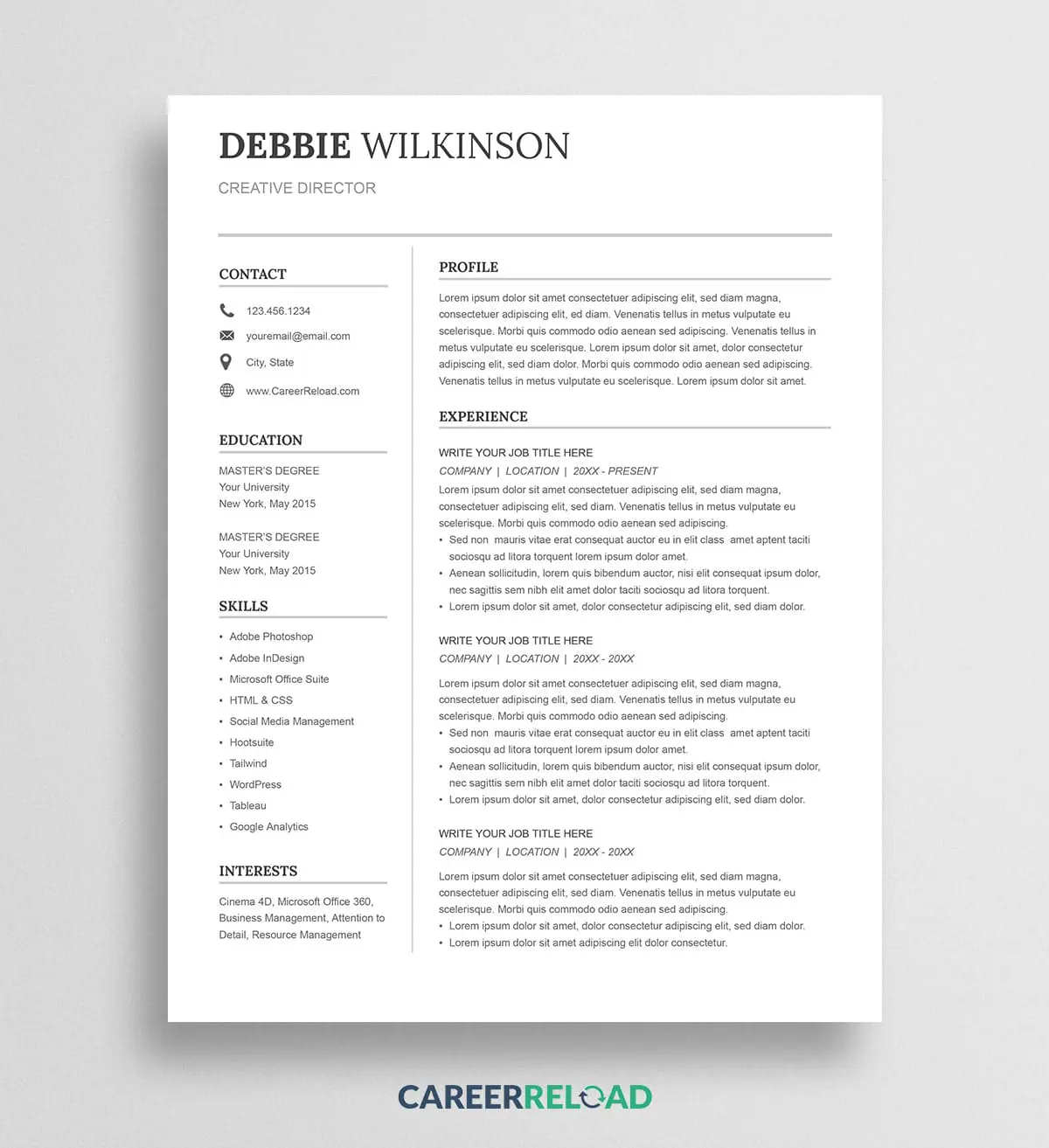Crafting a speech-language pathologist resume is more than an administrative task, it’s the start of your professional story. In a field where communication defines your career, your resume becomes the very first demonstration of how well you can present complex information clearly and persuasively. Employers often receive dozens of applications for a single opening, and standing out requires more than simply listing credentials. Your resume must show not only that you meet the technical requirements but also that you bring the compassion, precision, and adaptability that set exceptional speech-language pathologists apart.
This article guides you step by step through creating a document that highlights both your expertise and your unique strengths, ensuring you are remembered for more than just your qualifications.
Understand the SLP role and employer expectations
Before you start writing, it’s essential to think about the role itself. Employers hiring speech-language pathologists are not only evaluating technical skills but also the ability to connect with patients, collaborate with families, and communicate effectively with interdisciplinary teams. A strong speech-language pathologist resume should reflect that balance.
Clinical skills often include experience with articulation disorders, fluency interventions, voice therapy, and the use of augmentative and alternative communication systems. Employers also value familiarity with individualized education programs (IEPs), evidence-based therapy approaches, and the ability to measure progress using objective data. Alongside these competencies, soft skills such as patience, empathy, and the ability to explain complex treatment plans in simple terms are crucial.
Credentials are non-negotiable. A hiring manager will expect to see your Certificate of Clinical Competence (CCC-SLP) or progress toward it, state licensure, and any specialty certifications. These aren’t just formalities, they demonstrate commitment to professional standards and reassure employers that you can handle the responsibilities of the role.
Speech-language pathologist resume example (Word version)
Here’s a complete example of a speech-language pathologist resume for someone with 5 years of experience. View more resume examples.

Speech-language pathologist resume sample (copy-paste)
Your Name
Title
Phone Number | Email Address | City, State | LinkedIn
Summary
Speech-language pathologist with 5 years of experience delivering evidence-based therapy in school and clinical settings. Skilled in assessing and treating articulation, fluency, and language disorders across pediatric and adolescent populations. Recognized for compassionate care, interdisciplinary collaboration, and measurable improvements in communication outcomes. Certified by ASHA with current state licensure.
Skills
- Pediatric speech and language assessment
- Articulation and phonological therapy
- Fluency and voice disorder intervention
- Augmentative and alternative communication (AAC)
- Individualized Education Program (IEP) development
- Parent and caregiver training
- Multidisciplinary collaboration
- Bilingual: English/Spanish
Professional experience
Speech-Language Pathologist, Palm County School District
West Palm Beach, FL, August 20XX – Present
- Provide speech and language services to 45+ students across elementary and middle school levels with diverse communication needs.
- Collaborate with teachers, occupational therapists, and psychologists to create and implement IEPs tailored to each child’s goals.
- Designed and facilitated group therapy sessions that improved social communication skills in students with autism spectrum disorder.
- Integrated AAC devices into classroom routines, increasing functional communication for nonverbal students.
- Delivered professional development workshops for faculty on supporting language development in the classroom.
Speech-Language Pathologist, Sunrise Pediatric Therapy Clinic
Miami, FL, June 20XX – July 20XX
- Conducted comprehensive evaluations for children ages 3–12 with speech, language, and fluency disorders.
- Developed individualized therapy plans resulting in measurable improvements in 80% of caseload within 6 months.
- Educated parents and caregivers on strategies to reinforce therapy goals at home.
- Collaborated with physicians and audiologists to support patients with complex medical needs.
- Documented progress in compliance with insurance and Medicaid requirements.
Education
Master of Science in Speech-Language Pathology
Florida State University – Tallahassee, FL
Graduated: May 20XX
Bachelor of Arts in Communication Sciences and Disorders
University of Florida – Gainesville, FL
Graduated: May 20XX
Certifications and licenses
- Certificate of Clinical Competence in Speech-Language Pathology (CCC-SLP), ASHA
- Licensed Speech-Language Pathologist, State of Florida
- CPR and First Aid Certified
Professional development
- Annual ASHA Convention attendee (20XX–20XX)
- Workshop: “Advances in AAC Technology for School-Based SLPs” (20XX)
Select the right format and layout
Once you know what you need to emphasize, the question becomes how to present it. For most candidates, the reverse-chronological format is the most effective. It immediately highlights your most recent and relevant experiences, which is where employers tend to focus first.
The layout should reflect your professionalism. Simple, modern designs with plenty of white space allow the content to shine. A clean font such as Calibri or Arial makes your information accessible, while subtle use of bold or italic text can guide the reader’s eye without overwhelming them. Length should be considered strategically: new graduates or those early in their careers should aim for one page, while clinicians with extensive experience can confidently extend to two pages if every line adds value.
Think of your resume as a therapy plan, it should be structured, easy to follow, and purposeful from start to finish.
Here are some stylish resume layouts for Word and Google Docs.
Write a compelling summary or objective
At the top of your resume, a short paragraph sets the tone for everything that follows. For experienced professionals, a summary highlights the breadth of clinical expertise and career accomplishments. It might mention years of practice, patient populations served, and a commitment to evidence-based care. For those just entering the field, an objective works better by communicating enthusiasm, career goals, and the desire to grow under supervision.
The goal is to capture attention quickly. Instead of vague statements about being “hard-working” or “dedicated,” use specific language: “Speech-language pathologist with three years of experience in pediatric outpatient therapy, specializing in fluency and language development.” This kind of clarity reassures employers that you not only understand your skills but can communicate them effectively. An essential trait in the profession itself.
Curate a standout skills section
Skills sections often end up as generic lists, but they can be powerful when tailored to the role. For a speech-language pathologist resume, think of skills in two categories: clinical and interpersonal.
Clinical skills might include:
- Designing and implementing individualized treatment plans
- Using AAC devices and technology-based therapy tools
- Conducting swallowing assessments and dysphagia management
- Collaborating on IEP development and progress tracking
Interpersonal skills are equally vital: empathy, teamwork, adaptability, and cultural competence all make a measurable difference in patient outcomes. The key is to mirror the language of the job posting. If a school emphasizes “collaboration with educators,” make sure your skills section reflects that. Applicant tracking systems scan for these keywords, and matching them naturally will increase your chances of moving forward.
Showcase relevant experience
Experience sections can easily become laundry lists of duties. Instead, frame each role as a series of contributions and results. Start with your title, workplace, and dates, then follow with two to four bullet points that describe achievements. For instance, rather than stating “conducted speech therapy sessions,” say “designed individualized therapy programs for 25 elementary school students, resulting in measurable improvements in language comprehension scores.”
Numbers add credibility, but context matters just as much. If you worked in a clinical fellowship, highlight the range of disorders treated and the supervision received. If you transitioned from a related healthcare role, emphasize transferable skills like patient education or interdisciplinary communication.
For those at the start of their career, internships and clinical placements deserve equal attention. Employers understand that early-career professionals may not have years of experience, but they will look for initiative, adaptability, and readiness to learn. By focusing on what you achieved during placements, you show that you already know how to apply your training in real-world contexts.
Document education and certifications clearly
Speech-language pathology is a credential-driven field, so your education and certifications must be presented clearly. Start with your highest degree, including the institution, location, and graduation date. If you are a recent graduate, you can add honors or relevant coursework, but for seasoned professionals, this is unnecessary.
Certifications should follow, listed in a straightforward manner. Include the Certificate of Clinical Competence in Speech-Language Pathology (CCC-SLP) if earned, state licenses, and any additional specialized training such as swallowing therapy or bilingual certification. For recent graduates who are candidates for certification, indicate that status. This shows employers you are on track with the profession’s requirements.
Placing education above or below experience depends on your career stage. If you are early in your career, lead with education to highlight your training. If you are experienced, your work history should take precedence.
Optionally add professional development and extras
Beyond the basics, additional sections can give you a competitive edge. Professional development activities such as conferences, workshops, or continuing education courses show a commitment to lifelong learning. A value highly regarded in healthcare.
Volunteer work can also strengthen your resume, particularly if it connects to communication, advocacy, or community support. For instance, volunteering with a literacy program demonstrates your dedication to improving language skills outside clinical practice. Publications, research projects, or professional memberships such as the American Speech-Language-Hearing Association can be included if relevant to the role.
Unique qualities, like fluency in another language or specialized expertise in augmentative and alternative communication, can also distinguish you. These extras aren’t filler, they offer insight into what makes you different from other candidates with similar credentials.
Optimize and tailor for each application
No matter how polished your speech-language pathologist resume is, it must be tailored for each job. Employers often use applicant tracking systems that scan for specific keywords, so aligning your resume with the job description is essential. Study the posting carefully, identify the most emphasized skills and responsibilities, and adjust your language to match.
Tailoring also means prioritizing. If a hospital emphasizes swallowing disorders, highlight your experience in that area. If a school district values collaboration with teachers, push that to the top of your experience section. This doesn’t mean rewriting the entire document, it means strategically emphasizing what matters most for each opportunity.
Conclusion
Writing a speech-language pathologist resume is an exercise in communication, strategy, and self-reflection. It’s not only about listing where you studied or where you’ve worked. It’s about telling the story of how you use your skills to improve lives.
By understanding employer expectations, choosing a professional format, crafting a compelling summary, highlighting both clinical and interpersonal skills, and tailoring each application, you put yourself in the best possible position. Remember that your resume is not a static document. As your career grows, so should your resume, reflecting new skills, experiences, and achievements.
When done thoughtfully, your resume does more than open doors, it demonstrates the very abilities that define a great speech-language pathologist: clarity, empathy, and effectiveness

We’re a team of writers dedicated to providing insights and tips for navigating the professional world. With a collective wealth of experience across various industries and roles, our team understands the challenges and opportunities that come with seeking meaningful work and advancing your career. We help job seekers to better their careers by offering career advice & free resources. Download free Word resume templates and resume templates for Google Docs.




Others also read
How to Pass a Pre-Employment Personality Test
How to Customize your Resume for Different Industries
Which Resume Format is Right for You
How to Write a Resume Summary and Why You Need One
15 of The Best Jobs for High Schoolers
4 AI Tools to Help You Prepare for a Job Interview
How to Build a Resume for Free
Soft And Hard Skills You Should List On Your Resume
You Might Also Like These Free Templates
Google Docs Resume Format – Debbie
Free Resume Form Template
Free Resume Design – Megan
2 Column ATS Resume Template
ATS Friendly Resume Format for Word – Lindsay
Goal Planner Template
Cover Letter Template with Monogram
Professional Cover Letter Template
Free Modern Resume Template for Word
Free Job Application Tracker for Excel
Free Resume Template Download for Word – Farrah
Free ATS-Friendly Resume Template – Emily